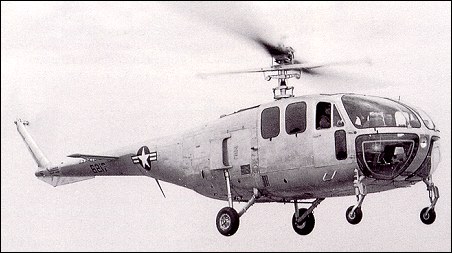| Picture |

|
| Manufacturer |
Bell
|
| Type |
48 / XR-12B
|
| Introduced |
1/1/1946
|
| In production? |
No
|
| Units produced |
13
|
| Price US $ |
175,000.00
|
| Overall Length |
56.8 ft
|
| Length |
39.6 ft
|
| Height |
11.3 ft
|
| Width |
0 ft
|
| |
|
| |
|
| Description |
This light, single piston engine helicopter used the rotor system of the Bell 47, although the machine itself was much bigger. There were two variants, a civilian version called Model 42 and the military Model 48. The latter was a response to the US Air Force demand for a military utility helicopter, which became designated as the XR-12.
Bell developed (1946) two versions of Model 48, the XR-12 and the YR-12. The first version had a nose section and doors that looked very much like those used in a car. The YR-12, meanwhile, had quite a different nose section, with a lot of glass and doors that fit in the fuselage very naturally. This version also used a more powerful engine, while the three-cycle landing gear was replaced with a quad-cycle version.
These models were not, however, successful, with all of them having major problems with the rotor system. By the time these issues were resolved, the US Air Force had already cancelled its order and was considering purchasing the Sikorsky S-51.
A minor spin-off was the (Italian) Agusta-Bell AB102, which used the Model 48 technology with a fuselage design of its own. Only two production models were built and sold. This all took place in the early 1960s, by which time the turbine helicopter was already dominating this market segment. As it turned out, the AB102 was already obsolete at the time of its introduction.
|
| Advertisement |
|
| Design features |
- Large two-blade rotor with stabilizer bar
- Four wheels undercarriage
|
This light, single piston engine helicopter used the rotor system of the Bell 47, although the machine itself was much bigger. There were two variants, a civilian version called Model 42 and the military Model 48. The latter was a response to the US Air Force demand for a military utility helicopter, which became designated as the XR-12.
Bell developed (1946) two versions of Model 48, the XR-12 and the YR-12. The first version had a nose section and doors that looked very much like those used in a car. The YR-12, meanwhile, had quite a different nose section, with a lot of glass and doors that fit in the fuselage very naturally. This version also used a more powerful engine, while the three-cycle landing gear was replaced with a quad-cycle version.
These models were not, however, successful, with all of them having major problems with the rotor system. By the time these issues were resolved, the US Air Force had already cancelled its order and was considering purchasing the Sikorsky S-51.
A minor spin-off was the (Italian) Agusta-Bell AB102, which used the Model 48 technology with a fuselage design of its own. Only two production models were built and sold. This all took place in the early 1960s, by which time the turbine helicopter was already dominating this market segment. As it turned out, the AB102 was already obsolete at the time of its introduction.
|
|
- Advertisement -
|
Design features:
- Large two-blade rotor with stabilizer bar
- Four wheels undercarriage
|
| Persons |
10
|
| Max. Range |
300 mi
|
| Cruise Speed |
90 mph
|
| Max. Speed |
105 mph
|
| Max. rate of Climb |
450 ft/min
|
| HOGE ceiling |
0 ft
|
| Service Ceiling |
12800 ft
|
| Gross Weight |
6286 lb
|
| Empty Weigt |
0 lb
|
| Useful Load |
0 lb
|
| Fuel Capacity |
0 gallons
|
| Number of Engines |
1
|
| Engine Type |
Piston
|
| Engine Code |
Pratt & Whitney R-1340-55 Wasp
|
| Horse Power |
600
|
| Rotorhead |
Teetering
|
| Number of rotorblades |
2
|
| Rotor Diameter |
47.5 ft
|
| Number of tail rotorblades |
2
|
| Tailrotor Diameter |
0 ft
|
|